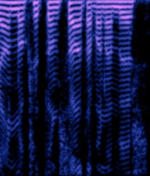Voice Inversion Scrambling
VIS, or Voice inversion scrambling, is a property of a NFMNarrowband Frequency Modulation signal that allows for scrambled transmissions to take place.
It obscures the content of a transmission. It is sometimes used in public service radio, automobile racing, cordless telephones and the Family Radio Service. Without a descrambler, the transmission makes the speaker "sound like Donald Duck", or a false LSBLower Side Band Modulation or USBUpper Side Band Modulation (Radio, referring to reception and modulation mode)Universal Serial Bus (Computer, referring to USB Ports and cables) signal that had been detuned slightly, depending on scrambling parameters set forth by the scrambler hardware. . It is called "voice inversion", but the technique operates on the passband of the information and so can be applied to any information being transmitted, thus leading to the "false" LSBLower Side Band Modulation/USBUpper Side Band Modulation (Radio, referring to reception and modulation mode)Universal Serial Bus (Computer, referring to USB Ports and cables) detuned signals.
Since analog NFMNarrowband Frequency Modulation in the US is slowly dying out (with the exception of a couple of systems) and fewer systems implemented this.
